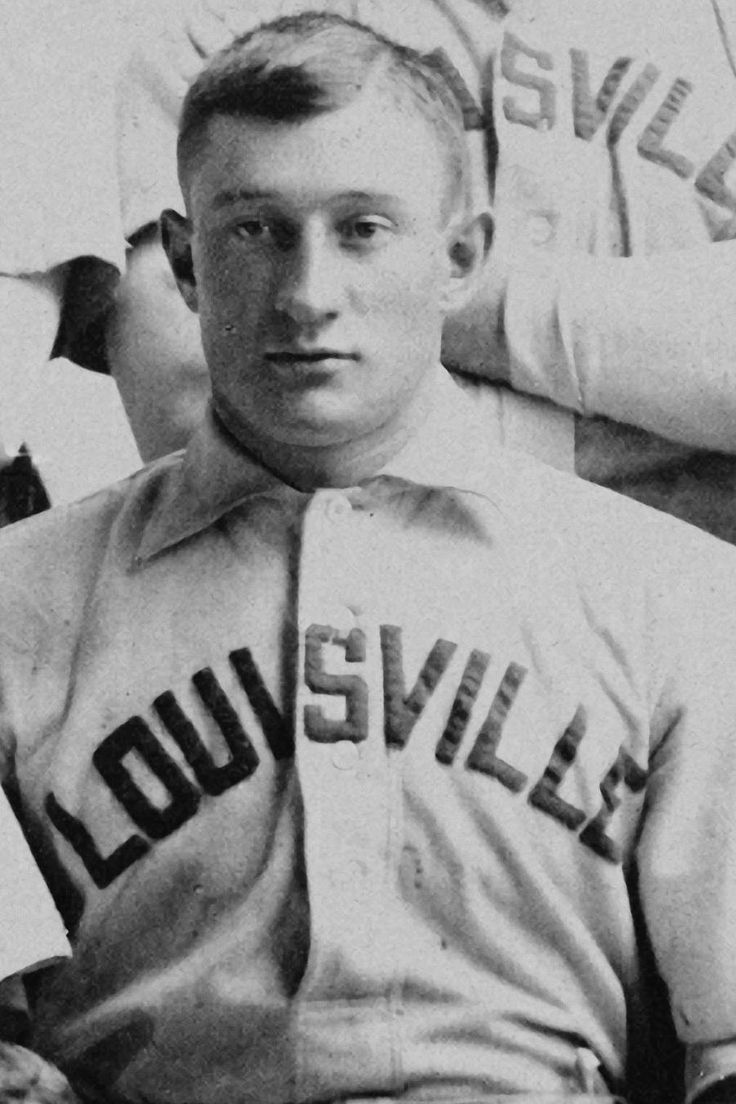|
Honus Wagner
Johannes Peter "Honus" Wagner ( ; February 24, 1874 – December 6, 1955) was an American baseball shortstop who played 21 seasons in Major League Baseball (MLB) from 1897 to 1917, mostly with the Pittsburgh Pirates. Nicknamed "the Flying Dutchman" due to his superb speed and German heritage, Wagner was a prototypical five-tool player, known for being a versatile defender who could combine a strong throwing arm with the ability to play almost any defensive position as well as being capable of hitting for average and for power. He is widely regarded as the greatest shortstop of all time. In , the National Baseball Hall of Fame and Museum, Baseball Hall of Fame inducted Wagner as one of 1936 Baseball Hall of Fame balloting, the first five members. At the age of 15, Wagner began his professional baseball career in the minor leagues in 1889. After being noticed by a talent scout, he made his MLB debut in 1897 with the Louisville Colonels. Wagner excelled at playing any position bot ... [...More Info...] [...Related Items...] OR: [Wikipedia] [Google] [Baidu] |
Shortstop
Shortstop, abbreviated SS, is the baseball positions, baseball or softball fielding position between second base, second and third base, which is considered to be among the Defensive spectrum, most demanding defensive positions. Historically, the position was assigned to defensive specialists who were typically poor at batting and were often placed at the bottom of the Batting order (baseball), batting order. Today, shortstops are often able to hit well and many are placed at the top of the lineup. In the Baseball positions, numbering system used by Baseball scorekeeping, scorers to record defensive plays, the shortstop is assigned the number 6. More hit balls go to the shortstop than to any other position, as there are more Right-handedness, right-handed hitters in baseball than Left-handedness, left-handed hitters, and most hitters have a tendency to Pull hitter, pull the ball slightly. Like a second baseman, a shortstop must be agile, for example when performing a Glossary of b ... [...More Info...] [...Related Items...] OR: [Wikipedia] [Google] [Baidu] |
Earned Run Average
In baseball statistics, earned run average (ERA) is the average of earned runs allowed by a pitcher per nine innings pitched (i.e. the traditional length of a game). It is determined by dividing the number of earned runs allowed by the number of innings pitched and multiplying by nine. Thus, a lower ERA is better. Runs resulting from passed balls, defensive errors (including pitchers' defensive errors), and runners placed on base at the start of extra innings are recorded as unearned runs and omitted from ERA calculations. Origins Henry Chadwick is credited with devising the statistic, which caught on as a measure of pitching effectiveness after relief pitching came into vogue in the 1900s. Prior to 1900 and for many years afterward, pitchers were routinely expected to pitch a complete game, and their win–loss record was considered sufficient in determining their effectiveness. After pitchers like James Otis Crandall and Charley Hall made names for themselves as rel ... [...More Info...] [...Related Items...] OR: [Wikipedia] [Google] [Baidu] |
Strikeout
In baseball or softball, a strikeout (or strike-out) occurs when a batter accumulates three strikes during a time at bat. It means the batter is out, unless the third strike is not caught by the catcher and the batter reaches first base safely as a result. A strikeout is a statistic recorded for both pitchers and batters, and is usually denoted by the letter K, or sometimes by the initialism SO. A " strikeout looking"—in which the batter does not swing and the third strike is called by the umpire—may be denoted by an inverted K (i.e. ꓘ). Although a strikeout suggests that the pitcher dominated the batter, the free-swinging style that generates home runs also leaves batters susceptible to striking out. Some of the most prolific home run hitters of all time (such as Adam Dunn, Mickey Mantle, Reggie Jackson, Alex Rodriguez, and Jim Thome) were notorious for striking out often. Notably, Jackson and Thome respectively hold the major league records for most and second mo ... [...More Info...] [...Related Items...] OR: [Wikipedia] [Google] [Baidu] |
Earned Run
In baseball, an earned run is any run that was fully enabled by the offensive team's production in the face of competent play from the defensive team. Conversely, an unearned run is a run that would not have been scored without the aid of an error or a passed ball committed by the defense; it is "unearned" in that it was, in a sense, "given away" by the defensive team. Earned and unearned runs count equally toward the game score; the difference is purely statistical. Both total runs and earned runs are tabulated as part of a pitcher's statistics, but earned runs are specially denoted because of their use in calculating a pitcher's earned run average (ERA), the number of earned runs allowed by the pitcher per nine innings pitched (i.e., averaged over a regulation game). Thus, in effect, the pitcher is held personally accountable for earned runs, while the responsibility for unearned runs is shared with the rest of the team. To determine whether a run is earned, the official sco ... [...More Info...] [...Related Items...] OR: [Wikipedia] [Google] [Baidu] |
Innings Pitched
In baseball, the statistic innings pitched (IP) is the number of innings a pitcher has completed, measured by the number of Batter (baseball), batters and baserunners that have been put out while the pitcher is on the Baseball field#Pitcher's mound, pitching mound in a game. Three outs made is equal to one inning pitched. One out counts as one-third of an inning, and two outs as two-thirds of an inning. Sometimes, the statistic is written 34.1, 72.2, or 91.0, for example, to represent innings, innings, and 91 innings exactly, respectively. Runners Glossary of baseball (L)#left on base, left on base by a pitcher are not counted in determining innings pitched. It is possible for a pitcher to enter a game, give up several hits and possibly even several runs, and be removed before achieving any outs, thereby recording a total of zero innings pitched. Alternatively, it is possible for a pitcher to enter a situation where there are two runners on base and no outs. He could throw one p ... [...More Info...] [...Related Items...] OR: [Wikipedia] [Google] [Baidu] |
Catcher
Catcher is a position in baseball and softball. When a batter takes their turn to hit, the catcher crouches behind home plate, in front of the (home) umpire, and receives the ball from the pitcher. In addition to this primary duty, the catcher is also called upon to master many other skills in order to field the position well. The role of the catcher is similar to that of the wicket-keeper in cricket. Positioned behind home plate and facing toward the outfield, the catcher can see the whole field, and is therefore in the best position to direct and lead the other players in a defensive play. The catcher typically calls for pitches using PitchCom, or hand signals. The calls are based on the pitcher's mechanics and strengths, as well as the batter's tendencies and weaknesses. Essentially, the catcher controls what happens during the game when the ball is not "in play". Foul tips, bouncing balls in the dirt, and contact with runners during plays at the plate are all events ... [...More Info...] [...Related Items...] OR: [Wikipedia] [Google] [Baidu] |
Pitcher
In baseball, the pitcher is the player who throws ("Pitch (baseball), pitches") the Baseball (ball), baseball from the pitcher's mound toward the catcher to begin each play, with the goal of out (baseball), retiring a batter (baseball), batter, who attempts to either make contact with the pitched ball or draw a base on balls, walk. In the numbering system used to record defensive plays, the pitcher is assigned the number 1. The pitcher is often considered the most important player on the defensive side of the game, and as such is situated at the right end of the defensive spectrum. There are many different types of pitchers, such as the starting pitcher, relief pitcher, middle reliever, left-handed specialist, lefty specialist, setup man, and the closing pitcher, closer. Traditionally, the pitcher also bats. Starting in 1973 with the American League and spreading to further leagues throughout the 1980s and 1990s, the hitting duties of the pitcher have generally been given over t ... [...More Info...] [...Related Items...] OR: [Wikipedia] [Google] [Baidu] |
National League (baseball)
The National League of Professional Baseball Clubs, known simply as the National League (NL), is the older of two leagues constituting Major League Baseball (MLB) in the United States and Canada, and the world's oldest extant professional team sports league. Founded on February 2, 1876, to replace the National Association of Professional Base Ball Players (NAPBBP) of 1871–1875 (often called simply the "National Association"), the NL is sometimes called the Senior Circuit, in contrast to MLB's other league, the American League, which was founded 25 years later and is called the "Junior Circuit". Both leagues currently have 15 teams. The National League survived competition from various other professional baseball leagues during the late 19th century. Most did not last for more than a few seasons, with a handful of teams joining the NL once their leagues folded. The American League declared itself a second major league in 1901, and the AL and NL engaged in a "baseball war" durin ... [...More Info...] [...Related Items...] OR: [Wikipedia] [Google] [Baidu] |
Barney Dreyfuss
Bernhard "Barney" Dreyfuss (February 23, 1865 – February 5, 1932) was an executive in Major League Baseball who owned the Pittsburgh Pirates franchise from 1900 to his death in 1932. He was inducted into the National Baseball Hall of Fame in 2008. Dreyfuss is often credited with the creation of the modern baseball World Series. He also built one of baseball's first modern steel and concrete baseball parks, Forbes Field, in 1909. During his period of ownership, the Pirates won six National League pennants, plus World Series titles in 1909 and 1925; only the New York Giants won more NL championships (10) during the same period. Early years Dreyfuss was born in Freiburg, Grand Duchy of Baden in 1865. He attended school in Freiburg and later worked in a bank in nearby Karlsruhe. At the age of 16, he emigrated, in 1881, to the US to escape conscription into the German Army. At the time, his prospects of being drafted into the military were high and, as a young Jew, his potential ... [...More Info...] [...Related Items...] OR: [Wikipedia] [Google] [Baidu] |
National Baseball Hall Of Fame And Museum
The National Baseball Hall of Fame and Museum is a history museum and hall of fame in Cooperstown, New York, operated by a private foundation. It serves as the central collection and gathering space for the history of baseball in the United States displaying baseball-related artifacts and exhibits, honoring those who have excelled in baseball positions, playing, manager (baseball), managing, and serving the sport. The Hall's motto is "Preserving History, Honoring Excellence, Connecting Generations". Cooperstown is often used as shorthand (or a Metonymy, metonym) for the National Baseball Hall of Fame and Museum. The museum also established and manages the process for honorees into the Hall of Fame. The Hall of Fame was established in 1939 by Stephen Carlton Clark, an heir to the Singer Sewing Machine Company, Singer Sewing Machine fortune. Clark sought to bring tourists to the village hurt by the Great Depression, which reduced the local tourist trade, and Prohibition in the U ... [...More Info...] [...Related Items...] OR: [Wikipedia] [Google] [Baidu] |







